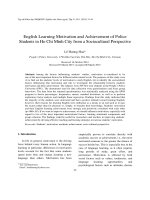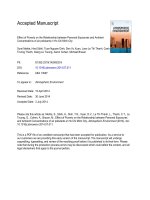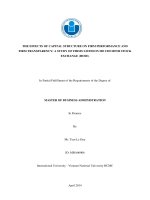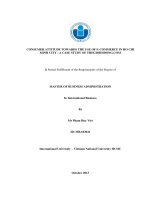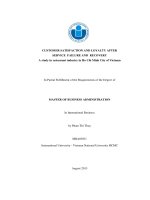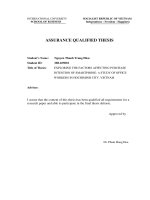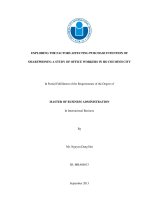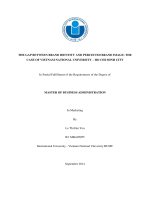Internal market orientation and customer oriented behavior a study of banking industry in ho chi minh city
Bạn đang xem bản rút gọn của tài liệu. Xem và tải ngay bản đầy đủ của tài liệu tại đây (859.49 KB, 84 trang )
UNIVERSITY OF ECONOMICS HO CHI MINH CITY
International School of Business
------------------------------
TRAN VO ANH TUYEN
INTERNAL MARKET ORIENTATION AND
CUSTOMER-ORIENTED BEHAVIOR
A Study of the Banking Industry in Ho Chi Minh City
MASTER OF BUSINESS (MBUS)
HO CHI MINH CITY_2014
UNIVERSITY OF ECONOMICS HO CHI MINH CITY
International School of Business
------------------------------
TRAN VO ANH TUYEN
INTERNAL MARKET ORIENTATION AND
CUSTOMER-ORIENTED BEHAVIOR
A Study of the Banking Industry in Ho Chi Minh City
ID: 22120116
MASTER OF BUSINESS (MBUS)
SUPERVISOR: LE NGUYEN HAU
HO CHI MINH CITY_2014
ACKNOWLEDGMENT
First of all, I sincerely thank the board of school, professors in
University of Economics Ho Chi Minh City, who spent effort and enthusiasm
on teaching, communicating the precious knowledge about my major during
the two years of study, as well as necessary specialized skills; so that I have full
capital for performing this research.
Next, I would specially like to send deeply gratitude to supervisor Le
Nguyen Hau, who has dedicated instructions, creates necessary and convenient
conditions, is always willing to help, gives suggestions, and advises me, in
order to choosing topic, determining the correct direction for the study and
completed thesis in the best way.
Finally, to complete the perfect and full study, I would genuinely like to
thank for getting the attention and support of selected banks in survey. They
kindly cooperate to quickly finish for collecting the accurate data, and the
model is used in study achieved high reliability. Especially, I truly thank all
tellers and individual customer relationship officers working at SeAbank-Ho
Chi Minh branch, who offer useful advices for research having practical
information.
Again, faithfully thank all those who contribute to help me complete the
study.
Yours sincerely,
Tran Vo Anh Tuyen
ABSTRACT
The customer orientation of service personnel is often regarded as a
main determinant of service firms’ success. Namely, front-line service
employees are a primary contact point in banking settings and the way their
behaviors are perceived by customers is a critical antecedent of customer
satisfaction. For this reason, purpose of the present study is to recognize how
internal marketing orientation affects customer-oriented behavior of service
personnel in banking industry. In the paper, we have used a questionnaire with
twenty-five main questions in order to survey two hundred and fifty tellers and
individual customer relationship officers at joint stock commercial banks in Ho
Chi Minh city. Besides, a model has been designed to show the effect of
components belonging to internal marketing orientation on customer-oriented
behavior through employee commitment factor based on previous literature
review. As well as, a theoretical framework has been developed to prove
empirically with an application of regression analysis. Implications of the
findings for customers' overall satisfaction level replying on customer-oriented
behavior are discussed. From creating the motivation, capacity building, and
opportunity environment for employees show their performance, in order to
bring organizational competitiveness, lead to customer satisfaction. Finally, the
expected contribution of this study is that will be able to gain extend
knowledge about customer-employee interactions in banking industry in
Vietnam.
Keywords: Internal marketing orientation, Customer-oriented behavior,
Employee commitment, Banking industry, Frontline service employees.
TABLE OF CONTENTS
CHAPTER 1. INTRODUCTION
1.1 Research Background ............................................................................. 1
1.2 Research Problem .................................................................................... 2
1.3 Research Objective .................................................................................. 6
1.4 Scope of the Research.............................................................................. 6
1.5 Structure of the Thesis ............................................................................ 7
CHAPTER 2. LITERATURE REVIEW AND RESEARCH MODEL
2.1 Literature Review .................................................................................... 9
2.1.1 Customer-Oriented Behavior (COB) ............................................. 9
2.1.2 Internal Market Orientation (IMO) ................................................ 11
2.1.2.1 Internal Information Generation (IIG) ............................... 13
2.1.2.2 Internal Communication (IC) ............................................. 14
2.1.2.3 Internal Responsiveness (IR) ............................................. 15
2.1.3 Employee commitment (EC) ......................................................... 16
2.2 Hypotheses and Research Model ........................................................... 17
2.2.1 Hypotheses ..................................................................................... 17
2.2.2 Conceptual Model .......................................................................... 20
CHAPTER 3. RESEARCH METHODOLOGY
3.1 Research Design ....................................................................................... 22
3.1.1 Research Context and Method ....................................................... 22
3.1.2 Sample selection and data collection ............................................. 24
3.2 Measurement of Constructs ................................................................... 25
CHAPTER 4. RESULTS
4.1. Descriptive Statistic ................................................................................ 27
4.1.1 Description of the survey data ....................................................... 27
4.1.2 Descriptive data in the questionnaire ............................................. 28
4.1.2.1 Descriptive statistic for demographic variables ................. 28
4.1.2.2 Descriptive Statistics of the Constructs ............................. 31
4.2 Results ....................................................................................................... 33
4.2.1 Reliability and Validity.................................................................. 33
4.2.2 Hypotheses tests............................................................................. 36
4.2.3 Analysis of the causal relationships among the variables of the
model ............................................................................................................... 37
CHAPTER 5. CONCLUSION
5.1 Discussions and implications .................................................................. 40
5.2 Study Limitations and Future Research ............................................... 43
5.2.1 Limitations ..................................................................................... 43
5.2.2 Recommendations for the future research ..................................... 44
5.3 Conclusion ................................................................................................ 45
References ...................................................................................................... 47
Appendix ........................................................................................................ 69
Questionnaire ................................................................................................. 71
LIST OF TABLES AND FIGURES
Table 3.1. Measures underlying the constructs ............................................... 25
Table 4.1. Descriptive Statistics of the Constructs .......................................... 31
Table 4.2. Meaning of Mean ........................................................................... 32
Table 4.3. Rating the Acceptance for Constructs of Banks ............................ 32
Table 4.4. Reliability and Convergent validity ............................................... 34
Table 4.5. The Correlation Matrix for Variables............................................. 35
Table 4.6. Summary of results ......................................................................... 37
Figure 2.1. The proposed model of critical factors to customer-oriented
behavior ........................................................................................................... 21
Figure 4.1. Gender Ratio of the Banks Participating in the Survey ................ 28
Figure 4.2. Education Level Ratio of the Banks Participating in the Survey
......................................................................................................................... 29
Figure 4.3. Working Time Ratio of the Banks Participating in the Survey ....
......................................................................................................................... 30
Figure 4.4. Results of causal relations of the model ....................................... 39
Appendix 1: Total Variance Explained ........................................................... 68
Appendix 2a: Model Summaryb ...................................................................... 68
Appendix 2b: Model Summaryb ...................................................................... 69
Appendix 3a: Coefficientsa .............................................................................. 69
Appendix 3b: Coefficientsa ............................................................................. 69
Internal Market Orientation and Customer-Oriented Behavior:
A Study of the Banking Industry in Ho Chi Minh City
1
CHAPTER 1. INTRODUCTION
1.1 Research Background
In service organizations, many researchers have demonstrated that
customer preferences are influenced by interactions between employees and
customers (Bowen, 1986; Kohli & Jaworski, 1990; Gremler, Gwinner &
Brown, 2001) and have argued that an adequate focus on service personnel
(Berry, 1995) is also considered to be the important element of the firm’s
marketing mix (Nicoulaud, 1989) in an almost parallel research stream
(Gronroos, 2006). The origin of this research stream can be found as the
internal marketing (IM) concept introduced by Berry, Hensel and Burke
(1976). They have suggested that the regulations that apply to the company’s
external market are relevant for its internal market in similar way. The center of
internal marketing efforts is the management of relationship between internal
customers and internal suppliers (George, 1990; Lings, & Brooks, 1998) for
service-mindedness and customer-oriented behavior (Berry, 1981; Gronroos,
1989), and importantly for successful exchanges with external markets (Flipo,
1986). Based on this concept, not many companies succeed in implementing
IM, largely because of the inadequacy of unanimously-agreed upon definitions
and lack of clarity with respect to the operation of the IM concept (Gronroos,
1991; Greene, Walls, & Schrest, 1994). Towards this end, Lings and Greenley
(2005) have developed an instrument to measure internal market orientation
(IMO) in a retail industry and suggested that the IMO has positive
consequences in different service contexts and be examined in different cultural
settings.
Internal Market Orientation and Customer-Oriented Behavior:
A Study of the Banking Industry in Ho Chi Minh City
2
Following the tendency of western counterparts, service organizations in
fast developing countries, such as: India, China, are implementing marketing
concepts and strategies towards increasing customer satisfaction and loyalty
through improved service quality (Choudhury, 2008; Dutta & Dutta, 2009).
Based on effects found empirically in developed countries (Wright,
Filatotchev, Hoskisson & Peng, 2005), the adoption of internal market
orientation of developing countries comes into question because of their
various contexts: different cultural, social, economic and regulatory conditions
(Lachman, Nedd & Hinings, 1994; Kirkman & Shapiro, 1997; Venkatesh, Bala
& Sykes, 2010). In this regard, rightly pointed out by Zinkhan and Hircheim
(1992), Sheth and Sisodia (1999) and more recently Sheth (2011), marketing is
a contextual discipline, where context matters due to unique characteristics and
existing practices and perspectives of emerging markets.
1.2 Research Problem
The banking sector plays a very important role to the fortunes of the
country's economy (Alfaro, Chanda, Kalemli-Ozcan & Sayek, 2004), where
coordinates currency supply and demand, is bridge, which supports activities
for the development of other industries (Herring & Santomero, 1995; Levine,
1997; Tyler & Stanley, 2007). As we knew, banking industry has a lot of
business operations, but raising capital and credit are traditional operations that
decide the existence of a bank (Grinblatt & Titman, 2002). Besides, banks in
Vietnam are operating on the field: retail banking, because only with this
operation, they can raise capital (Vietnamplus, 2013). Therefore, employees
who interact with customers are a key part of the bank (Jamal & Naser, 2002;
Jayakody & Sanjeewani, 2006) when bank wants to sustainably develop and
increase competitive advantage.
Internal Market Orientation and Customer-Oriented Behavior:
A Study of the Banking Industry in Ho Chi Minh City
3
The survival of banks bases on capital raised by customers (Razzaque,
2009). If they can't attract capital inflows from market (Mishkin, 2006), banks
will, of course be eliminated. Meanwhile, as noted, the risk of bank is replaced
in Vietnam, because of customers, is quite high. With low switching costs,
customers almost no loss what if they want to transfer their funds out of the
bank and invest in another place (Finance Newspaper, 2013).
On the other hand, at present, there are too many banks in Vietnam, but
really there are not strong banks with international stature. Banks are
scrambling to scale the network to raise capital (width development). This has
led to a situation that credit institutions compete fiercely with each other in
activities and forget credit products and services utilities attach with them (Viet
Capital Securities, 2008).
Moreover, the bank expands scale but lack of quality human resources;
thus, management activities haven't kept up the development scale. Economic
crisis has lasted from 2008 to now, also bringing many difficulties for the
banking industry. Some banks have been not able to maintain growth in the
past year (Vietnam News Agency, 2013). This is the basis for many merger
experts stating the comment that the merger trend in the banking industry is
approaching. Currently, the intrinsic difficulties in Vietnam’s banking system,
is a major challenge for the economy. Restructuring the banking system is a
critical requirement, but also is an arduous route that banks have to undergo
(Vietnamplus, 2013).
In the nutshell, banks want to maintain the growth, survive and firmly
develop. They must change internal policies, robustly implement human
resource reform, so that making increase competitive advantage from their own
Internal Market Orientation and Customer-Oriented Behavior:
A Study of the Banking Industry in Ho Chi Minh City
4
differences (Gummesson, 1987; Lings & Brooks, 1998; Lings, 2004).
Considering agents or entities other than customers or competitors becomes
crucial elements in running of the organization (Yoon, Seo & Yoon, 2004). The
workforce has a greatest influence on the business results of any enterprise,
which is an unprecedented strategic importance for system (Post, Preston &
Sachs, 2002). This reality explains the current trend of marketing research into
the sphere of internal organization. Indeed, based on the basis of the theoretical
reference constituted by the stakeholder orientation, the orientation towards
employees and considering them as internal customers of the bank has become
the subject of study that named internal marketing (Collins & Payne, 1991;
Rafiq & Ahmed, 1993; Gounaris, Vassilikopoulou, & Chatzipanagiotou, 2010).
In addition, different papers have centered on the services sector defend the
adoption of internal marketing, favoring the satisfaction of the contact
personnel and their commitment to constructing good relationships with
external customers (Schneider & Bowen, 1985; Rogers, Clow & Kash, 1994).
Rely on the definition by Rafiq and Ahmed (2000), and from scale of
measurement of Lings and Greenley (2005), known as internal market
orientation (IMO). Nevertheless, it is not clear if marketing constructs such as
market orientation (MO) and internal market orientation (IMO) developed and
validated primarily using data from the western world can be employed in
developing countries (Sin, Alan, Yau, Lee & Chow, 2002). Concepts of MO
and IMO are quite novel and pertinent for developing countries, and
specifically, the banking industry has been slow to adopt marketing as a
management
discipline
(Calantone
&
Mazanec,
1991;
Gounaris,
Vassilikopoulou, & Chatzipanagiotou, 2010). Therefore, it is believed that a
study of internal market orientation in the banking industry can enhance the
Internal Market Orientation and Customer-Oriented Behavior:
A Study of the Banking Industry in Ho Chi Minh City
5
overall understanding of the concept of market orientation in banking in
particular and the service industry context in general.
On the other hand, previous theories have proved that banks which focus
their activities on the needs of their customers, meaning behave in a customeroriented way, their performance has been better than those banks that do not
(Donavan, Brown & Mowen, 2004). The economic potential of customeroriented behavior has empirically been substantiated by studies of Narver and
Slater (1990), and Jaworski and Kohli (1993). Besides, customers often rely on
the behavior of service employees who directly contact with customers for
judging the quality of a service in each bank (Dwyer, 1987; Choudhury, 2007).
Consequently, the level of customer orientation of bankers is considered as a
crucial leverage for service banks’ success about economic aspect (Bowen &
Schneider, 1985; Bitner, Booms & Tetreault, 1990; Bove & Johnson, 2000;
Sergeant & Frenkel, 2000).
Notice to improve business performance, providing services to clients
better, as well as increase the competitive advantage (Gwinner, Gremler &
Bitner, 1998) of banks in Ho Chi Minh city. Besides, banks aim to find
solutions to improve their face, explore out the main factors affecting their
business activities; in order to offer the appropriate remedial measures (Lings
& Greenley, 2005), so that banks can create higher labor productivity, and keep
talents in the organization; finally, leading to long term profit for organization
(Siguaw & Brown, 1994). However, based on the actual study situation, so far
the number of specific research projects have given the impact factors as well
as the ability of the factors affecting the operation of such banks in Ho Chi
Minh city, is very limited, mainly in qualitative researches. Therefore, in this
context, employees’ customer-oriented behavior (COB) will certainly make a
Internal Market Orientation and Customer-Oriented Behavior:
A Study of the Banking Industry in Ho Chi Minh City
6
difference and betterment in terms of improving customers’ overall satisfaction
in the banks. Given this situation, the paper explores the influence of IMO on
front-line service employees’ customer-oriented behavior in the banking
industry in Vietnam, particularly in Ho Chi Minh city.
1.3 Research Objective
Particularly, this current research is aimed to achieve the following objectives:
To identify and examine quantitatively the influence of components of
internal market orientation (IMO) on front-line employee commitment (EC)
to a bank.
To investigate the impact of employee commitment (EC) on customeroriented behavior (COB).
1.4 Scope of the Research
We have considered in terms of space aspect. The object of this project
is to study the joint-stock commercial banks in Ho Chi Minh city, namely large
branches, which belong to type one of the central districts like as district 1, and
district 3; for instance: SeABank (Southeast Asia Commercial Joint Stock
Bank), Kien Long Bank, Eximbank (Export Import Commercial Joint Stock
Bank), SCB Bank (Sai Gon Joint Stock Commercial Bank), and VCB (Bank
for Foreign Trade of Vietnam). Customer-oriented behavior has been examined
in organic relation with internal marketing orientation through the mediating
impact of employee commitment factor. In which we emphasizes the role of
the leading banks for retail banking operations to search customer and mining
customers thoroughly, aiming to eventually profit maximization, finally
bringing great benefits to the bank. However, due to the number of joint-stock
Internal Market Orientation and Customer-Oriented Behavior:
A Study of the Banking Industry in Ho Chi Minh City
7
commercial banks in Ho Chi Minh City is relatively large, with a variety of
activities, services, as well as various parts; thus we should only research
frontline staff, who directly take care of individual customers at banks, such as
tellers and individual customer relationship officers (CROs).
The next, considering in terms of time. Time study is more than 6
months, including time of data collection and data process is about 2 months.
1.5 Structure of the Thesis
The main contents of the thesis consist of five chapters, with summary
parts as following:
Chapter 1: Introduction
This sector points out that background of the overall situation, the role
and the platform of the banking sector and the current situation of the banking
industry in Vietnam, the urgency of research topic, as well as issues that need
to be clarified in the essay text. Chapter 1 shows out an overview of the
research topic, the scope and object of research.
Chapter 2: Literature Review and Research Model
We have based on previous research by researchers in different
countries. They have studied the same issue, in order that giving the concepts
and definitions about components, about various aspects of the factors in the
research. In addition, this part learns out the effects of the independent
variables on the dependent variable, with the direction and extent of the impact
of them. Thence, we draw hypotheses to present the relationship between
Internal Market Orientation and Customer-Oriented Behavior:
A Study of the Banking Industry in Ho Chi Minh City
8
variables. Finally, given a research model rely on previous studies, and the
hypotheses for better overall.
Chapter 3: Research Methodology
This chapter focuses on the items that belong to each component to
compose screening questionnaire, and then, selecting the appropriate number of
samples and conducted surveys at selected banks. After collecting enough
needed data, we conduct data processing, namely selecting tools, appropriate
methods to process and present data.
Chapter 4: Results
Presentation of results through data processing has been done in Chapter
3. Data must assure the reliability and validity, including: convergence validity,
and discriminant validity... forward the results to determine the influence of the
independent variables on the dependent variable, as well as their impact
direction, and testing of hypotheses have been drawn out in Chapter 2. Finally,
we come to the conclusion about the relationship between the variables and the
extent of effect.
Chapter 5: Conclusion
Besides making suggestions, proposals and solutions to improve and
promote the development of customer-oriented behavior of personnel
department at the bank, we also offer a limited sector, which most study
experiments have, when have studied in real environment, thereby giving the
direction to perform better for future researches.
Internal Market Orientation and Customer-Oriented Behavior:
A Study of the Banking Industry in Ho Chi Minh City
9
CHAPTER 2. LITERATURE REVIEW AND RESEARCH MODEL
2.1 Literature Review
In this section, we have summarized relevant literature on the components
of internal market orientation affecting to customer-oriented behavior of banks
through mediating variable, which is employee commitment with its
antecedents, as well as learning about customer-oriented behavior clearly, and
concretely that has placed in relationship to other factors based on previous
studies, and the research framework has used in this study (Chih & Li, 2006;
Lanjananda & Patterson, 2009; Johari & Hee, 2013).
2.1.1 Customer-Oriented Behavior (COB)
Customer orientation is one of the behavioral components of market
orientation (Narver & Slater, 1995); it is widely used in the marketing literature
(Saura, Contri, Berenguer, Taulet & Velazquez, 2005). According to Hartline,
Maxham and Mckee (2000) customer orientation is defined as the set of beliefs
that puts the customer's interest first at the firm level. Saxe and Weitz (1982);
Daniel and Darby (1997) define customer orientation as the willingness of
service providers to adjust their service delivery oriented to a customer's
situation, for example, needs, problems, special circumstances... at an
individual level.
Customer-oriented behavior refers to specific behaviors, that personnel
satisfy their customers through serve the service (Farrell, Souchon & Furden,
2001; Winsted, 2000a, b). Customers often rely on the behavior of employees,
who contact customers directly when judging the quality of a service that
belongs to firm (Levesque, & McDougall, 1996; Johnson, Sivadas, &
Internal Market Orientation and Customer-Oriented Behavior:
A Study of the Banking Industry in Ho Chi Minh City
10
Garbarino, 2008). Our conceptualization of customer-oriented behavior is
consistent with three works (Chih, & Li, 2006). Firstly, customer-orientation is
the degree to which an organization or its employees focus their efforts on
understanding and satisfying customers, that is suggested by Saxe, and Weitz
(1982). The second is customer-oriented behavior as the extent to which
service employees use their marketing concepts for helping customers to make
purchase decisions as well as satisfying their needs (Stock, & Hoyer, 2002).
Thirdly, customer-oriented behavior in terms of a tendency of employees to
meet needs of customer in job-related environment (Brwon, Mowen, Donavan,
& Licata, 2002). Consistent with these views, we define customer-oriented
behavior as the extent to which customer-contact employees use their
marketing concepts for satisfying customers’ needs. As a result, the customer
orientation level of service employees is considered a crucial leverage for the
service firms’ economic success (Bowen & Schneider, 1985; Bitner, Booms &
Tetreault, 1990; Bove & Johnson, 2000; Sergeant & Frenkel, 2000). Therefore,
customer-oriented behavior is necessary in fulfilling customers’ needs and
interests. Others researchers have mentioned that COB provides information
and assistance to reach customers satisfaction (Stock & Hoyer, 2005); in
addition to researchers who have analyzed the role of employees in customeroriented behavior as a dimension of service quality (Parasuraman, Zeithaml &
Berry, 1988; Dabholkar, Sheperd & Thorpe, 2000). In service industry, the
behavior of customer-contact employees plays key role during customers’
decision making process (Chih & Li, 2006). Consequently, customer-oriented
behavior could be as predisposition or tendency in the workplace (Donavan,
Brown & Mowen, 2004). It is a main determinant of customer overall
satisfaction in order to create a long-term profitable service organization
(Johari & Hee, 2013).
Internal Market Orientation and Customer-Oriented Behavior:
A Study of the Banking Industry in Ho Chi Minh City
11
In the banking context, it is explained that the term customer-oriented
behavior refers to the service behavior and ability of the service providers to
adjust their service in order to reflect reality of customers' demand (Daniel &
Darby, 1997). On the same note, Darby and Daniel (1999) have stated that
existing the interaction between employees and customers in the process of coproducing a service; therefore, customer-oriented behavior is an essential
interface element for customer-contact employees to meet the incremental
customers' expectation. As a result, customer's evaluation will be highly
depended on employee’s behavior that they frequently encounter (LengnickHall, 1996; Ndubisi & Wah, 2005). It is widely accepted that a customeroriented organization is more likely to generate satisfied customers and create
more favorable behavioral outcomes than organization that lack of customer
orientation (Brady & Cronin, 2001). In the nutshell, customer-oriented
behavior is believed to facilitate achievement of a bank's goal and increase its
performance (Dell, 1991; Johnson, Sivadas & Garbarino, 2008). Banks with
customer oriented employees have the competitive advantage over those do not
perceive customer-oriented behavior as an important factor for long-term
business development (Bruce, Bowman & Brown, 1998).
2.1.2 Internal Market Orientation (IMO)
Internal market orientation arises from the view that customer contact
personnel is of primary importance to service industries, and that satisfied,
committed and motivated front-line employees are essential if customers are to
perceive that they have received good service (Sasser & Arbeit, 1976; Berry,
1984; Berry & Parasuraman, 1991). This means that internal market orientation
focuses on customer contact personnel and treat the employees as customers of
the organization’s jobs is the foundation on which internal market orientation is
Internal Market Orientation and Customer-Oriented Behavior:
A Study of the Banking Industry in Ho Chi Minh City
12
based (Lings, 2004). The role of IMO in facilitating the relationship between
the company and its employees, as a prerequisite to effective relationships
between employees and their customers; so wants marketing be developed,
must to be examined in order that a more comprehensive approach (Chaston,
1994; Heskett, Jones, Loveman, Sasser & Schlesinger, 1994; Tannenbaum,
Beard & Gueutal, 1994; Lings, 2000; Conduit & Mavondo, 2000).
Internal market orientation, in another way, could consider as internal
marketing. Within a service business organization, internal marketing is more
important factor than conventional external marketing (Kotler, 2000).
Furthermore, internal marketing is the key to excellent service and to
successful external marketing, this viewpoint is indicated by Greene, Walls,
and Schrest (1994). In summary, IMO is about identifying and satisfying the
wants and needs of employees as the initial condition to satisfy wants and
needs of customers (Gronroos, 1982).
For internal aspects of organizational performance, such as employee
retention (Tansuhaj, Wong & McCullough, 1987; Comm, 1989; Berry &
Parasuraman, 1991), employee motivation and morale (Piercy, 1995; Van &
Bekkers, 1995), employee satisfaction (Piercy, 1995; Bowen, 1996) and
organizational commitment (Stauss & Schulze, 1990; Piercy & Morgan, 1990;
Berry & Parasuraman, 1991). Internal marketing orientation (IMO) has
implications, as well as for external aspects of performance; for example
service quality (Gronroos, 1981), customer satisfaction (Piercy, 1995) and
finally, financial performance (Tansuhaj, Randall & McCullough, 1988;
Crawford & Getty, 1991).
Internal Market Orientation and Customer-Oriented Behavior:
A Study of the Banking Industry in Ho Chi Minh City
13
The managerial behaviors have categorized in a manner consistent with
current marketing thinking; in particularly external market orientation (Kohli &
Jaworski, 1990) allows IMO to be viewed as the internal equivalent to market
orientation (Stauss & Schulze, 1990; Wasmer & Brunner, 1991; Piercy, 1995)
in the external context. As such, IMO involves the generation and
dissemination information (Tansuhaj, Randall & McCullough, 1988; Piercy,
1995; Reynoso & Moores, 1996), internal communications to the wants and
needs of employees, and the design and implementation of appropriate
responsiveness (Sasser & Arbeit, 1976; Berry & Parasuraman, 1991; Lukas &
Maignan, 1996) to meet these desires. The behavioral dimensions of IMO are
discussed in more detail below:
2.1.2.1 Internal Information Generation (IIG)
Informal information generation is about the needs and wants of staff in
day to day, face-to-face interactions between managers and employees.
Information generation relates to employees’ perceptions of the inputs to their
jobs, the outputs (what they receive) and the equity of this exchange (Lings &
Greenley, 2005). Lings and Greenley (2005) have also identified three modes
of information generation. They are formal written media, such as:
questionnaires and job satisfaction surveys, formal face-to-face interactions, as
interviews, and performance appraisals and meetings (Cobb, Samuels &
Sexton, 1998).
The necessity to collect information about the internal environment has
been identifiied by several researchers, for instance: Briscoe (1980); GomezMejia (1988); Huseman, and Hatfield (1990); Stauss, and Schulze (1990);
Cobb, Samuels, and Sexton (1998); Johlke, and Duhan (2000). They acquiesce
Internal Market Orientation and Customer-Oriented Behavior:
A Study of the Banking Industry in Ho Chi Minh City
14
generating information about exchanges of value in the internal market (Ewing
& Caruana, 1999), in particular what employees seek from their job, what they
are prepared to give up to get them and what competitors are offering in terms
of rotational employment. Segmenting the internal market based on differences
in the characteristics of employees in order to better identify the different needs
of these employees (Wasmer & Brunner, 1991; Piercy, 1995). The appropriate
internal market information includes: information about important attributes of
jobs, satisfaction of employees with their working conditions, the internal
factors that influence employee satisfaction.
2.1.2.2 Internal Communication (IC)
Communication means transferring information among people inside the
organizations (Johlke & Duhan, 2000). Gronroos (1990), Boswell and
Boudreau (2001) and Guest and Conway (2002) have mentioned that internal
communications are central to the alignment of employees’ attitudes with
organizational goals. The more communication, the more wants and needs
could be shared (Lings & Greenley, 2005). Communication between managers
and employees is a part of the internal marketing mix (Tansuhaj, Wong &
McCullough, 1987; Piercy, 1995). Besides, they stress the use of reports,
presentations
and
formal
meetings
as
effective
tools
support
for
communication. In addition, Hurley (1998) also point out that good
communication and response from mangers to employees, especially high
levels of IMO, rapidly facilitate acceptance of organizational directives and
behavior change in organization. Therefore, within people in organizations,
flow of information is very important. On the other hand, relationship between
employers and employees in communication has been shown to improve
employee outcomes and performance, especially front-line service staff (Johlke
Internal Market Orientation and Customer-Oriented Behavior:
A Study of the Banking Industry in Ho Chi Minh City
15
& Duhan, 2001). Consequently, in the internal market orientation context,
information dissemination is particularly important; so that adapting to needs of
the internal market, pertinent information has related to the internal market
must be communicated for an organization (Kohli & Jaworski, 1990).
2.1.2.3 Internal Responsiveness (IR)
Another category of IMO is involves the response to the information
among employees together about the wants and needs of individual employees
(Carter & Gray, 2007). Huseman and Hatfield (1990) have stated that internal
response could make some tangible social benefits such as status, recognition
for good work and sense of accomplishment. Therefore, managers need to
consider both the financial and social wants and needs of their employees
(Tansuhaj, Wong & McCullough, 1987).
Briscoe (1980) has also suggested some ways for internal response like
improving individual reward standard, changing working hour, provide flexible
physical settings and providing training. These activities belong to job design.
In addition, according to Huseman and Hatfield (1990), equity theory brings a
highly relevant insight to responsiveness in that the consideration must be
given to the way employees evaluate their jobs in terms of inputs and outputs.
One of the most common applications for IMO information is to create job’s
products, meeting the needs of employees and thus satisfying and motivating
them, which is suggested by several authors: Sasser, and Arbeit (1976); Stauss,
and Schulze (1990); Berry, and Parasuraman (1991). Consequently, internal
market research can identify how employees satisfied with their jobs, as well as
managers can respond by redesigning jobs to improve these outputs or change
perceptions about them (Sasser, & Arbeit, 1976; Lings, & Greenley, 2005).
Internal Market Orientation and Customer-Oriented Behavior:
A Study of the Banking Industry in Ho Chi Minh City
16
2.1.3 Employee commitment (EC)
Dordevic (2004) has pointed out that the commitment of employees is an
important issue because it may be used to predict employee’s performance,
absenteeism and other behaviors. It reflects the extent employees identify with
organization. Thus, high levels of commitment have led to several favorable
organizational outcomes (Dixit & Bhati, 2012). There are some studies showed
that it is important to understand employees’ behavior for measuring employee
commitment. In the nutshell, employee commitment encourages team and
individual to get goals, which in turn binds each member to the organization
(Jaworski & Kohli, 1993). In addition, Muthurveloo and Rose (2005) have
stated that the organizational commitment is the collective of employee
commitment that includes: work commitment, career commitment and
organizational commitment, which could support higher productivity. Besides,
the influence of organizational commitment on turnover intentions and on job
performance (Chughtai & Zafar, 2006). Organizational commitment leads to
positive organizational outcomes, which is examined by Muthuveloo and Rose
(2005). Nawab and Bhatti (2011) have pointed out that job satisfaction has the
highest impact on high employees’ commitment and productivity of
organization.
On the other hand, a positive correlation between organizational
commitment and job performance (Meyer, Paunonen, Gellatly, Goffin &
Jackson, 1989), or highly committed employee should have a weak intention to
leave organization, in comparision with low commitment has also been
associated with low levels of morale (DeCottis & Summers, 1987) non
committed employees, or negative relationship between turnover intentions and
organizational commitment (Mowday, Porter & Steers, 1982). As a result,
Internal Market Orientation and Customer-Oriented Behavior:
A Study of the Banking Industry in Ho Chi Minh City
17
employees who are committed to their respective organization, are not only
more likely to remain with the organization, are but also likely to exert more
efforts on behalf of the organization and work towards organization's success;
so they also exhibit better performance that the uncommitted employees.
Finally, employee commitment can bring benefits to organization; for
instance, it can improve performance and motivation (Mowday, Steers &
Porter, 1979); reduces absenteeism (Steers & Rhodes, 1978; Mathieu & Zajac,
1990), and less turnover absenteeism (Cotton & Tuttle, 1986) in order that
resulting in sustained productivity; thus increasing organization productivity
(Schuler & Jackson, 1996). Mowday, Steers and Porter (1979) have pointed out
that employees with high level of organizational commitment provide a secure
and stable workforce; thence providing competitive advantage to the
organization (Meyer & Allen, 1997; Colquitt, Lepine & Wesson, 2009).
2.2 Hypotheses and Research Model
2.2.1 Hypotheses
Internal information generation and its effect on employee commitment
Belonging to one of the researches of Lings and Greenley (2005), which
focus on the need to corroborate the possible causal order of the dimensions of
IMO. Deshpande and Zaltman (1982); Kohli and Jaworski (1990);
Diamantopoulos and Hart (1993); and Slater and Narver (1995) have
implemented several studies about marketing orientation (MO) with three
components of MO: generation, dissemination and response to the information
that have related to each other following a causal order, have derived from
internal information generation (IIG), which subsequently influences
Internal Market Orientation and Customer-Oriented Behavior:
A Study of the Banking Industry in Ho Chi Minh City
18
information dissemination, and finally the response made to the information
generated. In the same paper series, internal information generation has
affected the response or action, taken by managers towards their contact
personnel, regardless having first been distributed or communicated
(Deshpande & Zaltman, 1982; Lings & Greenley, 2005). We therefore
establish as hypothesis to be tested:
H1: Generation of internal information positively and considerably
influences on employee commitment.
Internal communication and its effect on employee commitment
Communication can be understood into the implicit communications
that impact service delivery; as well as the explicit communications that
employees receive. The role of implicit communications on employee behavior
is not straightforward. Often the message communicated to employees by their
organizational
context
is
not
directly related
to
explicit
messages
communicated in service directives or training sessions (Lings, Beatson, &
Gudergan, 2008). The internal communications have represented by IMO are
reported to enhance the association that employees feel for the firm and its
services (Bell, Menguc & Stefani, 2004). Communication has been particularly
important in influencing employee behavior such as service orientation
(George, 1990) and loyalty to the banks (Ozment & Keller, 1999). Both
attitudinal and behavioral elements are comprised in loyalty, as well as have
manifested in affective commitment (attitudinal loyalty) and staff retention
(behavioral loyalty). Affective commitment is particular interest, because it
creates changes in employee behavior towards customers. Once employees like
their jobs and feel a sense of affection towards their employers; consequently,


